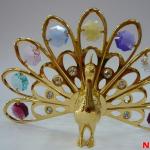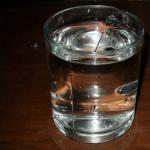Good afternoon, Dear Readers! Today we are going to talk about assembly. soldering station. So let's go!
It all started with the fact that I stumbled upon this transformer:
It is 26 volts, 50 watts.
As soon as I saw it, a brilliant idea immediately came to my mind: to assemble a soldering station based on this transformer. On Ali, I found this one. In terms of parameters, it is ideal - the operating voltage is 24 volts, and the current consumption is 2 amperes. I ordered it, a month later it came in shockproof packaging. In the picture, the sting burned a little, because I already connected the soldering iron to the transformer. I purchased the connector on the market, immediately with a connector for four wires.

But connecting the soldering iron directly to the transformer is too simple, uninteresting, and the tip will deteriorate so quickly. Therefore, I immediately began to think about the soldering iron temperature control unit.
At first, I thought over the algorithm: the microcircuit will compare the value from the variable resistor with the value on the thermistor, and, based on this, it will either supply current all the time (heating the soldering iron), or supply it in “packs” (temperature retention), or not supply it at all (when the soldering iron is not in use). For these purposes, the lm358 chip is perfect - two operational amplifiers in one package.
Soldering Station Regulator Diagram
Well, let's go directly to the scheme itself:
Parts list:
- DD1 - lm358;
- DD2 - TL431;
- VS1 - BT131-600;
- VS2 - BT136-600E;
- VD1 - 1N4007;
- R1, R2, R9, R10, R13 - 100 ohms;
- R3, R6, R8 - 10 kOhm;
- R4 - 5.1 kOhm;
- R5 - 500 kOhm (tuning, multi-turn);
- R7 - 510 Ohm;
- R11 - 4.7 kOhm;
- R12 - 51 kOhm;
- R14 - 240 kOhm;
- R15 - 33 kOhm;
- R16 - 2 kOhm (tuner);
- R17 - 1 kOhm;
- R18 - 100 kOhm (variable);
- C1, C2 - 1000uF 25v;
- C3 - 47uF 50v;
- C4 - 0.22uF;
- HL1 - green LED;
- F1, SA1 - 1A 250v.
Making a soldering station
At the input of the circuit there is a half-wave rectifier (VD1) and a current-quenching resistor.
Next, a voltage stabilization unit is assembled on DD2, R2, R3, R4, C2. This block lowers the voltage from 26 to 12 volts needed to power the microcircuit.

Then comes the control unit itself on the DD1 chip.

And the final block is the power part. From the output of the microcircuit through indicator LED the signal goes to the triac VS1, which controls the more powerful VS2.

We also need a few wires with connectors. This is not necessary (the wires can also be soldered directly), but just right for Feng Shui.

For a printed circuit board, we need a textolite with dimensions of 6x3 cm.

We transfer the pattern to the board using the laser-ironing method. To do this, print out this file, cut it out. If something is not transferred, we finish it with varnish.
(downloads: 262)

Next, we throw the board into a solution of hydrogen peroxide and citric acid (3: 1 ratio) + a pinch of table salt (it is a catalyst for a chemical reaction).

When the excess copper dissolves, we take out the board, rinse with running water

Then remove the toner and varnish with acetone, drill holes

And that's it! The printed circuit board is ready!
It remains to tin the tracks and solder the components correctly. Solder, focusing on this picture:

The following places must be connected with jumpers:

Yes, we have collected the fee. Now it would be necessary to place all this in the case. The base will be a square of plywood measuring 12.6x12.6 cm.

The transformer will be in the middle, fixed with screws on small wooden blocks, the board will “live” nearby, bolted to the base through the corner.
This circuit can also be powered by 12V, which makes it versatile. To do this, it is necessary to exclude DD2, R2, R3, R4 and C2 from the general scheme. Also, the thermistor in the circuit should be replaced with a constant resistor of 100 ohms.
This concludes my article. Good luck with your replay!
P.S. If the soldering iron does not start, check every connection on the board!
I wondered about making a case for this station. Of course, you can use the station in this form, but it is very dangerous for the station itself (the boards can short each other out if accidentally touched) and for the people around.
As options for making the case, I considered the following ideas:
- Print on a 3D printer
- Cut pieces of any flat material (acrylic, laminate, chipboard) and assemble from pieces
- Adjust the box to fit
The first two options involve careful preparation in the form of cabinet design, while the third is simply about finding a box of the right size, and New Year already on the nose and I want to start the soldering station as soon as possible, so for now I decided to try the third way, and then, if I don’t like it, I’ll redo it!
If you are a very greedy person, then as a case you can use plastic packaging from Korean carrots or from salted herring, but a plastic container purchased at the Wholesaler or at Jupiter will look much more beautiful.
I found a suitable size container, laid out the boards inside it so that they did not touch each other. I attached the plugs, shield and potentiometers to their future places, checked that they did not touch the boards. I made holes for the protruding elements with a drill, if they were required to be round, and with a scalpel heated on fire, if of a different shape. The GX-16 plugs and the 220v input wire socket with a fuse had to be disconnected from the board, as they are inserted into the holes from the OUTSIDE! At the same time, do not mix up the wires when connecting them in place! The boards inside were fixed with hot glue, but later I'm going to add a more secure fastening to them - with cable ties or metal screws.
And after assembling the device in the case, I randomly found that the resulting design in a 191x129mm plastic box fits perfectly on the bottom level of a standard 12-inch tool container! Thus, on the upper level of the same container, you can store a hair dryer and a soldering iron disconnected from the soldering station, and solder and other soldering accessories on the remaining part of the lower level!
I will not describe each step of manufacturing and assembly, instead I suggest that you familiarize yourself with the photo report. As they say, it's better to see once!
How to arrange components? We have the components Trying on The top shelf will store a hairdryer and soldering iron Already embedded external elements Shield and potentiometers in place Switch and fuse GX-16 Trial run Check soldering iron Future storage location Box dimensions printed on lid 12-inch case Top shelf
I thought for a long time whether to write an article about this homemade product or not. On the Internet, you can probably count a dozen articles on this scheme. But since, in my opinion, this particular circuit solution is the most successful, I share the design with you, dear visitors of the Technoobzor website. I want to immediately thank the author of the scheme for the work done, and for posting it for general use. The soldering station is quite simple to manufacture and is very necessary in amateur radio practice.
When I first started my career as a radio amateur, I didn’t think about any. Soldered with a powerful 60 watt soldering iron. Everything was done by surface mounting and thick wires. Over the years, with a little experience, the tracks became thinner and the details smaller. Bought soldering irons of lower power, respectively. I somehow bought a soldering iron from a LUKEY-702 soldering station with a maximum power of 50 watts and a built-in thermocouple. I picked up the scheme for assembly right away. Simple and reliable, as well as a minimum of parts.
Scheme of a homemade soldering station


List of parts for the circuit:
- R1-1M
- R2 - 1k
- R3 - 10k
- R4-82k
- R5-47k
- R7, R8 - 10k
- R indicator -0.5k
- C3 - 1000mF/50v
- C2 - 200mF/10v
- C - 0.1mF
- Q1-IRFZ44
- IC4-78L05ABUTR


The power transformer was taken from a turntable. His name is TS-40-3. Didn't rewind anything. All the appropriate voltages are already on it. To power the soldering iron itself, two windings were connected in parallel. It produces about 19 volts. We have enough. To do this, on this model of the transformer, it is necessary to put jumpers between the transformer terminals 6 and 8, as well as 6 'and 8' on the other coil. Remove voltage from pins 6 and 6'.

To power the microcontroller of the soldering station control unit and the op-amp, we need a voltage of 7.5 to 15 volts. You can, of course, up to 35, but this will be the limit for the 78L05 stabilizer microcircuit. She will get very hot. To do this, I connected the windings in series. The voltage was 12 volts. Two wires are soldered to the 8th output of the transformer. Solder, which is thinner, and shift it to a free terminal. The jumper must be placed on the 10th output of the transformer and the soldered wire. Voltage is removed from 10 'and 12 output. The above is only for the transformer TS-40-3.

Power diodes V1 are used by KD202K. Just right for this purpose. To power the MK, I took a small-sized diode assembly B2. E30361-L-0-8-W with a common cathode was used as LED indicators. He also spread his printed circuit board under your indicator. It turned out to be two-sided. Unilateral failed. Too many jumpers. The board is not the best, but tested and working. I also soldered the connector on the soldering iron itself. His standard is no good. At first, the booster was not provided on the board. I installed it after, but the board in the archive is fixed.


Picked up the best connector dad - mom from the available trash. I also want to say about the IRFZ44 field effect transistor. For some reason he didn't want to work with me. It burned out immediately when turned on. On the this moment For about a year now IRF540 has been standing. Almost does not heat up. It doesn't need a big radiator.
Soldering station - case manufacturing

So, the body of the soldering station. It's good when you go to the store, and there is a choice of ready-made cases. Unfortunately, I don't have that luxury. And I don’t really want to look for all sorts of boxes from it’s not clear what, and then I still don’t really want to think about how to stuff everything there. The body was bent out of tin. After I marked and drilled all the holes and painted with spray paint. I sealed the indicator hole with a piece of plastic from a black beer bottle. The buttons are made from Soviet cases of KT3102 transistors in an iron case and the like. You also need to calibrate the temperature readings using the resistor R5 and the thermocouple of the multimeter. After assembling and checking, I secured all the wires with plastic fasteners. After screwing the top cover of the case. The station is ready to go. Happy assembly everyone. The soldering station was made by Bukhar.
The kit for assembling the soldering station, which I ordered on AliExpress in two weeks, reached me by surprise, because I hadn’t even tried to think about where I would put it when I assembled it. I knew only one thing for sure - I would not buy a cheap plastic box for the amount of half the cost of the set. If an assembly kit is taken, which, in fact, is the fundamental complete set of the future device, then the radio amateur by default should be ready for the hassle of supplementing it with everything necessary. Otherwise, it is more correct to take a completely finished product. However, the desire to put it into operation as soon as possible prompted us not to manufacture the case from scratch, but to choose something suitable.
A modem was appointed as a donor, which for a long time and without any hope of returning to fulfilling its direct duties, was gathering dust in the corners. The fitting of the existing power supply was successful, and now it was necessary to place the control board of the soldering station in it.

The case as a whole, perfectly suitable for placing a PS in it, was unnecessarily flat in the front part - literally a few millimeters were not enough to install the control board in its original form. Which, as it turned out later, turned out to be for the best. I removed the encoder from the board and, without soldering, bent the electrolytic capacitor and the power connector into a horizontal plane. Since the aviation connector, the encoder and the indication LED had to be placed directly on the case, the corresponding wires were soldered to the latter to connect them to the board. On the seller's website, the connection of the control board and the soldering iron was shown bypassing the aviation connector, which is somewhat inconvenient during installation - I finished it.

At the next stage of work, I removed unnecessary inscriptions from the surface of the case (first with a hard piece of felt with a cleaner for burnt kitchen utensils - pemolux, then with a soft piece of felt with toothpaste, GOI paste did not fit here - plastic is too soft for it). I cut the encoder and the aviation connector, removing the filter from plexiglass cut through required opening and installed LEDs around the edges into the existing holes, there are two of them, one indicates the power supply is on, the second is the operation of the soldering station as a whole.

The switch was installed taken from a calculator from the USSR, it “cuts off” both the phase and zero, which is important, because the mains plug of the soldering station will always be in the socket. In the rear part of the internal cavity of the case there is a connector for connecting external consumers of 24-volt power supply (for example, a fan or a hand drill) and another switch that makes it possible to disable the “PS” function in the device and use only one power supply. As you can see, there was plenty of space for connecting wires in the case.

I was just lucky with the power supply, and stood in place as it should, and the necessary (for complete happiness) 24 volts 3 amperes are available. The bottom of the case already had a sufficient number of ventilation holes, so nothing was required to be drilled. Changed only the information label.

The general view of the internal device, I want to emphasize that the case already had almost all openings and holes for installing components, just enlarge something a little somewhere with a needle file or drill and that's it.

Here's what happened in the end of the hassle. I placed everything as it is convenient for me - the aviation connector on the right and the soldering iron in my right hand - respectively, the cable is also on the right, outside the soldering zone, the encoder can be twisted with the left and nothing obscures the view of the indication information. Written by Babay from Barnaula.
Discuss the article HOLDER FOR SOLDERING STATION




















